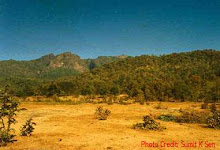Bandits in the Hinterland
Stretching over a span of almost one thousand plus kilometers Chambal River is a tourist’s paradise. Once famous for killer bandits hiding unseen in the maze of the sandy dunes, this region was a frightening travel prospect in the past. Horrifying tales of vengeance, vendetta, and loot emerged in Indian newspapers. The dreaded bandits killed many people every year. We read reports of over 400 people killed by just one bandit in cold blood purportedly carried out of vengeance.
Each criminal turned bandit had a sordid past of being victimized by higher caste landlords, family feuds, rape, loot, and plunder. Whether indulgence in cold-blooded murders of innocent had a backing of victimhood or was criminal indulgence out of instinct or bad company we could never find out as one tale after another emerged, of murders and dacoity unhindered. The news sent shivers in my spine albeit we were nowhere close to Chambal, but fear of ultras is always overpowering and frightening. Anyway, all that has been washed out, and the tourists can safely visit places of interest near the Chambal River.
Chambar River Tourism
Pristine yet backward, this hinterland has been transformed miraculously thanks to the tourism and development that follows. The dacoits have receded into the annals of history, and no untoward incident with the tourists has taken place. Due credit is given to MPTDC or Madhya Pradesh Tourism Development Corporation for promoting tourism in remote confines of the state wherever a definite potential exists.
A holiday at the confines of Chambal, a birding trip, or a boat ride is an enticing prospect for those who are fortunate enough to know about the destination. The destination is full of tourism potential and delivers a sound spiritual experience thanks to the time freeze, pristine splendor, and mysticism associated with the rivers like Chambal.
I have been to the river plenty of times on birding tours and the smells and the sounds of emptiness still linger in the convoluted labyrinths of my memory banks. The yonder blue sky, birds calling overhead, and ripples giving rise to tiny waves are what you will experience on a boat ride. Wait! There is much more to this riverine paradise untouched and unspoiled.
For the readers, all I have to say is, do visit once!
Boating at Chambal Quintessentially Romantic
Boating at Chambal is quintessentially romantic. The dull whirring of the motorboat engine surprisingly aligns with the aquatic ecosystem, the squeals of raptors and gulls skimming over the surface, and the turbid splash of Gangetic Dolphins sum up the moments you will encounter on a boat ride during the river tour. The sounds are often missing but the prevailing silence is broken now and then creating an esoteric environment in the nowhere lands of remote India. The slow almost motionless ride on the placid waters is paradoxically an unforgotten adventure to be. But few tourists visit this region primarily for boat rides. The shores are frequented by ornithologists from overseas and their guides on long extended birding tours. The Chambal Lodge at Bah in UP specializes in bird-watching tours in the confines and organizes a boat ride at Chambal. The package is beyond the reach of most holidaymakers in India. The MPTDC facility at Dholepur attracts crowds interested in the boat rides. It is very economical but of short duration.
For the bird and wildlife enthusiasts, it is the land of the living for there is much happening in the space frozen back in time. For domestic tourists, the ride is a spiritual awakening after the long hardy days of a fast-paced life of material pursuits in the urban chaos.
The river erupts every time a dolphin surfaces to breathe and dives back into the water in split seconds. A sudden surprising event the ornithologists await eagerly, they have come to watch the dolphins, gharials, muggers, and turtles besides wild animals at the shore and a plethora of birds in the sky. The targeted species are the Indian Skimmer, raptors, gulls, sand larks, cranes, and owls that reside in the cryptic crevices of the steep cliffs on the shores.
From the shore, the river appears quite welcoming to visitors on a bright sunny day. In the winter, the fog creates an uninviting almost life-threatening environment, and only the brave alight the boat for a ride in zero visibility. The braves are birders like us, always etching to enhance their experience besides the checklist. But as time goes past, the river with its turbulent history and temples on its shores will be flooded with holidaymakers. In a heavily populated country, the river and the sand dunes in the hinterland offer the feel of a sparsely populated environment - a much-wanted escape.
Stay at Chambal Lodge at Bah in UP
Our stay at Chambal Lodge has been most pleasing the property is primarily visited by overseas birding enthusiasts. The rustic environment and local food invite them to stay longer. The lodge has been created by converting an old Kothi or Indian noble house, the distinct architecture creates a unique experience during the day.
Our stay has been usually overnight. I would drive my group from Agra post a visit to the Taj Mahal and Fatehpur Sikri a day earlier. The drive on the luxury bus halts at many places for local bird watch but even after these hiccups, we manage to reach Bah by lunchtime. The evenings are reserved for local birding in the company of the lodge naturalist which is then followed by dinner and sound sleep.
The motorboat ride for the group is organized on the shore 22 km further. This is the best part of the tour and we spot all that is described above. From here we move on towards Nainital in Uttarakhand further North.
Chambal Factfile The waterbody cuts across three large states of India from its origin at Janapav in Mohw in MP to submergence in the Yamuna in Uttar Pradesh after flowing through the State of Rajasthan. The long river is one of the least polluted entities among the aquatic systems in India and yes the wildest.
Chambal region is known for its faunal assemblage on the shores and in the sandbars in between, two crocodile species, Gharial and marsh crocodiles, Ganges Dolphin, number of turtles, fish, and reptiles. This is a tourist’s paradise for sure and yet few visit the remote confines of the river famous for boat tours and wildlife.
Most of the visitors to this paradise which has been notified as a sanctuary are from foreign lands, they are keen birders. The assemblage of avian species is as impressive as the wild animals on the shores.
Unique Riverine Ecosystem
The dunes, shores, and flowing waters all combine to form an impressive spectacle and are home to a vast number of avian species. The targeted bird is of course the Indian Skimmer which arrives to nest here but other species do not lack in charm. The sand lark, painted stork, Bonelli’s eagle, osprey, wooly necked stork, chestnut bellied sand grouse, Indian eagle owl, bar-headed geese, river tern, black-bellied tern, Brahminy Duck, sarus cranes, are few stars that enamor bird enthusiasts.
You can see a lone hyena, sloth bear, otters, monitor lizard, jungle cat, wolf, occasional leopard, and jackal to name a few animals that inhabit the salient confines of this hinterland. The boat ride on Chambal is a unique experience in a country that comprises heavily populated regions and has entered the rat race. Nearing the confines of this pristine river is a transformation from the maddening crowd to serenity and peace.
The hamlets and green fields create an amazing landscape that captivates tourists as they trudge towards the river confines. The assemblage of rocky mountains, sand dunes, and tall trees creates a tapestry that inspires and enhances the traveler's spiritual quest. The journey is a pure bundle of delights and a soul-stirring experience.
The best way of observing the enchanting landscape of Chambal is on a motorboat tour. The looming sandy mountains, steep cliffs, small islets upon waters, green fields, quaint hamlets, and the surging waters of the river create a striking symmetry comprising of natural objects and painted by nature's brush using exotic colors from a robust palette. As the boat goes past, the small islets can be seen full of crocodiles and turtles. The clear water is like a mirage full of dainty aquatic creatures. The calm shores populated with rocks, sand, and the ubiquitous greenfields create a mesmerizing mosaic as the boat sails past.
On the boat, you dwell in a surreal world an ethereal experience that is far removed from ours. Lost and stunned you wish the ride would continue forever. The boat is a motorboat and offers two and half hours of safari on the river. One of the best experiences in India is near Agra. From here the drive to the shore is 90 km. The enchanting Chambal river safari is organized by Chambal Lodge at Bah. Bah township is 70 km from Agra. Another option is at Dholepur in Rajasthan organized by MPSTDC this is less costly but a shorter ride and not so engrossing. Dholepur is sixty kilometers from Agra. From New Delhi, the city of the Taj Mahal is two and half hours drive.
============================
Uday is a blogger and writes on many topics. He blogs for many websites on wildlife/travel and hospitality. He also provides digital marketing with a focus on content and SEO.

















































